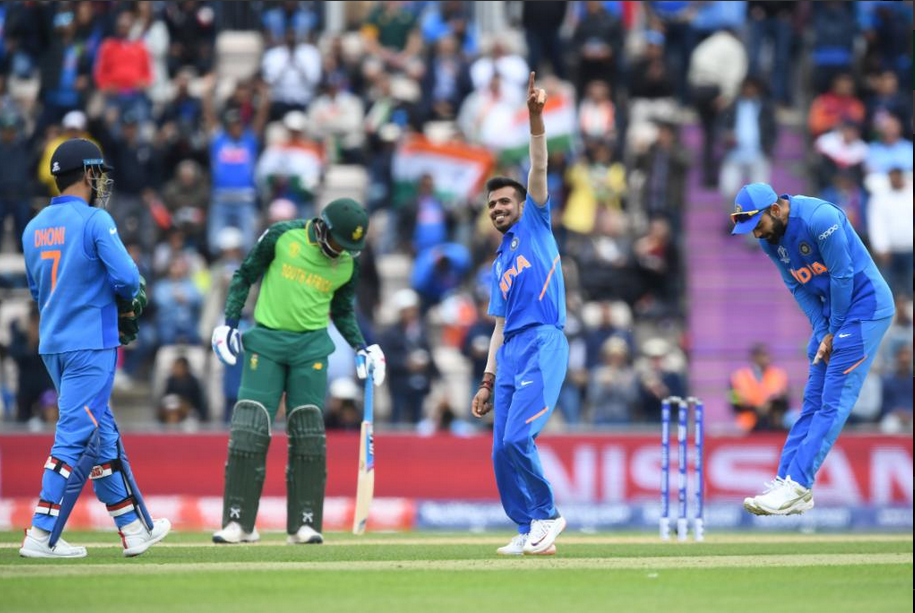SA’s clueless approach to the India wrist-spinners further highlighted the team’s lack of progress over the past year, writes JON CARDINELLI.
Rabbits in the headlights. Tharn. (That’s Rabbit language for the condition – think Watership Down). Call the condition what you want, as it all amounts to the same thing.
The Proteas were at a loss to counter the mesmerising wrist-spin of Yuzvendra Chahal and Kuldeep Yadav in the bi-lateral series against India last year. They appeared just as confused and confounded when they fronted the duo in the crucial World Cup fixture on Wednesday.
The capitulation at the Rose Bowl got me thinking about something JP Duminy said after the Proteas’ loss to India at Newlands last year. Duminy admitted that the South African batsmen were battling to read Chahal and Kuldeep.
The senior statesman assured everyone at that press conference – and by extension, the Proteas’ fan base – that more time and energy would be invested into formulating an effective counter-strategy.
The Proteas went on to lose that series 5-1. The India wrist-spinners combined to take 33 wickets (at an average of 15) across those six matches in South Africa.
Sixteen months have passed since that embarrassing result. The Proteas have had time to reflect and address their issues against wrist-spin, as well as their other batting concerns.
And yet here we are, three games into the World Cup campaign. Evidently, no significant progress has been made and the South Africans face the prospect of an early exit from the tournament.
CHAHAL AND KULDEEP vs SA’S TOP SIX BATSMEN
| DISMISSALS IN 2018 SERIES | 2019 CWC MATCH | |
| CHAHAL |
12 |
3 |
| KULDEEP |
8 |
1 |
Jasprit Bumrah, the quick bowler who enjoyed plenty of success on that tour to South Africa in 2018, removed Hashim Amla and Quinton de Kock. From there, skipper Virat Kohli deployed Chahal, Kuldeep and Kedar Jadhav as India looked to exploit the Proteas’ weakness against quality slow bowling.
Chahal ripped through the middle order, dismissing Faf du Plessis and Rassie van der Dussen in one over, and then David Miller later in the innings. Kuldeep trapped Duminy lbw to reduce the Proteas to 89-5.
The all-rounders and tail-enders fought hard to boost the score to 227. While it was a brave rearguard effort, it was never going to compensate for the failure of South Africa’s top six.
The Proteas’ batting weaknesses have been thoroughly exposed at this World Cup. After three games – against hosts England, so-called minnows Bangladesh, and India – only three half-centuries have been scored by individual batsmen. Too many have got a start and then conspired to throw away their wickets through rash shot selection and decision-making.
The failures of the top six have heaped the pressure on the rest of the team. Collectively, the specialist batsmen have managed only four partnerships of 50 runs or greater at this tournament. They’re yet to produce one stand of 100 or more.
SA PARTNERSHIPS AT 2019 WORLD CUP
| V ENG | V BANG | V INDIA | |
| 1ST WICKET |
36 |
49 |
11 |
| 2ND |
8 |
53 |
13 |
| 3RD |
85 |
45 |
54 |
| 4TH |
13 |
55 |
2 |
| 5TH |
2 |
26 |
9 |
The performance against India confirmed that the Proteas batsmen are no better equipped to deal with Chahal and Kuldeep now than they were 16 months ago. If South Africa do progress to the semi-finals, they will have no reason to believe that they can combat the England quicks or the India wrist-spinners.
The failures at the Oval, as well as the recent implosion at the Rose Bowl will be forgotten if the Proteas go on to win the World Cup.
If they don’t lift the trophy, however, questions should be asked about their approach and whether those who are steering the ship – Ottis Gibson and his coaching staff – could have done more to improve the side in the lead-up to the all-important tournament.
Photo: Cricket World Cup/Twitter







